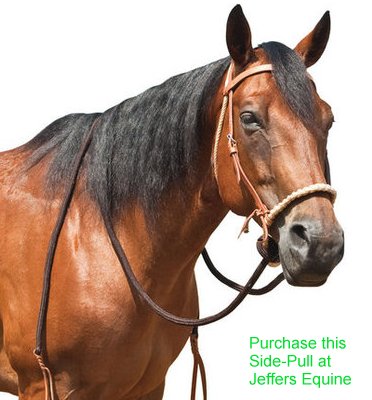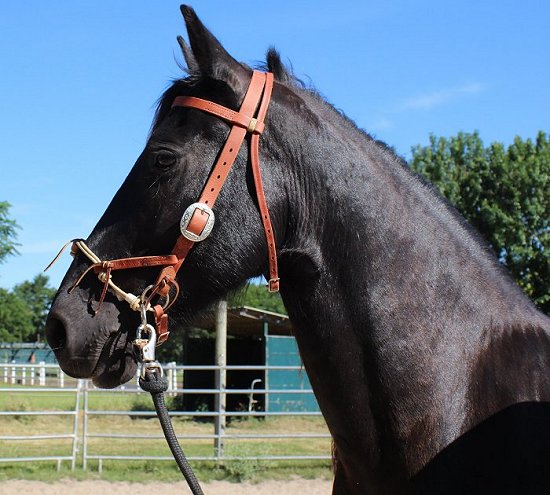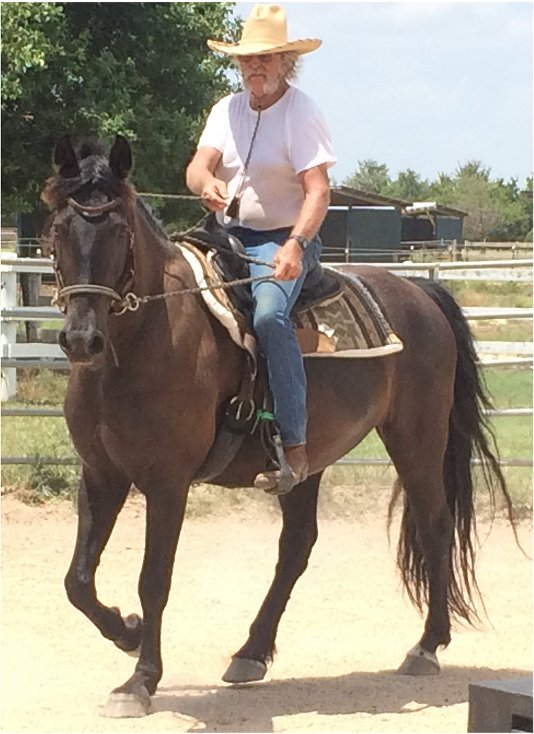 The side-pull or “breaking hackamore” is used completely without a bit. Generally, it is used when a colt is first broke to take a rider. It offers good lateral control without confusing him with a bit or damaging his mouth if hard pulls are necessary. The pressure is on the rope nose piece that can “bite” if used harshly. It mimics the knotted-nose halter but has better rein attachments and sturdier construction.
The side-pull or “breaking hackamore” is used completely without a bit. Generally, it is used when a colt is first broke to take a rider. It offers good lateral control without confusing him with a bit or damaging his mouth if hard pulls are necessary. The pressure is on the rope nose piece that can “bite” if used harshly. It mimics the knotted-nose halter but has better rein attachments and sturdier construction.
Nearly all of the horses that I train stay in the side-pull for life. Using a side-pull makes sure that no one can mis-use a bit or use it as a crutch to “get around” good training. Your horse should be able to perform easily and safely through “weekend warrior” type riding in this type of gear. There is some highly precise training that can benefit from a bit in the hands of a skilled trainer, but I still believe that hard work on the ground and a good rider in the saddle can cure almost any ill that most people try to cure with a bit – no matter the breed.
If the horse has been trained to be “light as a feather” on the lateral and vertical flex and the “whoa”, a side-pull is a beautiful piece of equipment. Get that “soft touch” flexion, and even the lightest hands can use a side-pull with real finesse.

It’s a hard sell, and even some of the young trainers I work with feel compelled to think “bit”. Training with a bit is just “the way it has always been done”.
It is not necessarily the way it should be done. Many outside trainers who watch one of our horses being trained in a side-pull keep pushing for a bit but are unable to give specifics of why it is necessary – especially in the early stages of training.
Here is a great example of a side-pull “bitless” bridle that incorporates both a rope halter and leather headstall. Similar to wearing a halter but more convenient, attractive, and precise.
Follow Reign’s under-saddle immersion training using only a side-pull.

Here’s another version of a side-pull being used for the early phase of neck reining training.
Horse training can be dangerous. Not all methods work on all horses. Instruction presented here is not meant to be prescriptive in nature, and Horse-Pros.com takes no responsibility for the welfare of any animal or person using our methods.
We certainly don’t know everything. Please share your expertise and experiences. Comment on what is already written or Suggest a Category and Educate us about it. Grow Horse-Pros.com©

A friend recommended this site for your problem. I am not familiar with this trainer, but my friend speaks very highly of her Maybe it will help.
http://straightnesstraining.com/where-to-start/
I have tried many bits on my gaited KMSH. She is sweet and wants to do what you ask, but continually seeks to lean on the bit; be it a shank bit or a snaffle. I seem to have trouble stopping this behavior. My thought was to try a bosal or a side-pull. What do you think? Her leaning on the bit has caused problems with self carriage, especially at the canter. Don’t know why gaited horses have more trouble balancing than a non gaited horse, without a bit to lean on. HELP!
Hi Bunny: I may be showing my ignorance (I don’t have or train gaited horses), but I thought that most gaited horses do not canter well at all (under any circumstances). I am always in favor of trying less bit instead of more, so I would say give a sidepull a try. But maybe someone is reading who has more knowledge than I. I hope they will give you some experiential advice.
I started riding gaited horses about 30 years ago. Before that, I rode hunter/jumpers and dressage. My understanding is that gaited horses are started so young that they are not trained for self carriage. I have had 3 now, a TWH, a Paso and a mountain horse. None could canter well with my weight, but did fine in the pasture. They all had me trained to have contact on the bit and then began to lean on it. Never had this problem with QHs or Thoroughbreds. However, many others have taught gaited horses to do a beautiful canter, inc. a slow easy canter. People that assume that gaited horses are easier to ride haven’t ridden one.
You are educating me beyond my current knowledge. We have had two TWH’s. Both were too hot for my liking. Neither one cantered well, but we are not experts, and we just took their nice, long stride and avoided the canter. I hear you about “easier to ride”. As a rider of non-gaited western trail horses, I never got good at riding the gaited mares. I seemed to always be off balance and unable to “get into it”, but my sister was totally committed to them. There’s a horse for everyone :*) I hope someone will find your information and help us both out. In the meantime, if you try the sidepull, let us know if it helps.